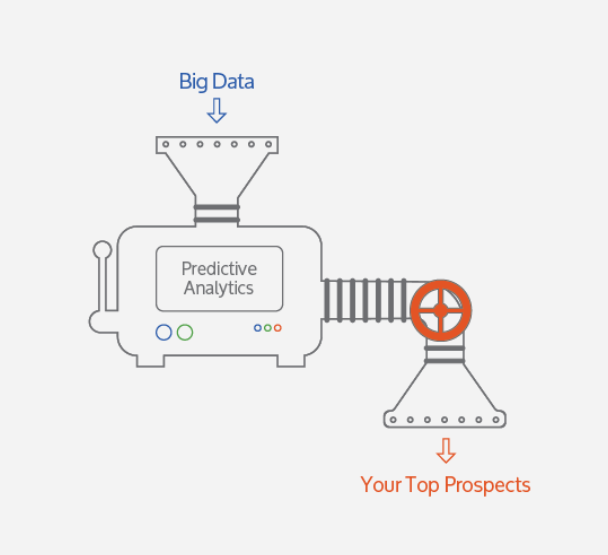You are viewing our site as an Agent, Switch Your View:
Agent | Broker Reset Filters to Default Back to ListMoving the Dial: 6 ways agents use data to get listings
May 30 2017
Whether you’re a second-year agent or the broker of a market-leading office, you’re running the numbers all year long — you can likely rattle off everything from GCI to lead conversion stats to ROI on tech and marketing products in your sleep.
While this kind of analysis is critical to running a successful operation, it’s hardly any different from what agents and brokers were doing in the 1970s. Black-and-white data is the bread and butter of any old school business, but smarter real estate companies are using predictive analytics to uncover new opportunities in the real estate industry.
What does predictive analytics do within real estate?

You may wonder how agents and brokers can take advantage of algorithmic predictions — and that’s a great question. The real estate industry is so expansive, there are truly hundreds of ways that data will make an impact on our business in the years to come.
SmartTargeting, the leader in predictive analytics for real estate, lending and other related industries, focuses on helping agents and brokers identify highly likely buyers and sellers from their sphere and geographic farm areas. The predictions are tricky, but the mission is simple: Optimize your time and marketing budget by focusing on the homeowners most likely to need your services in the next year.
A six-step plan for putting data into action
Not everyone is ready for a full predictive marketing platform, but every agent and broker should be working their way towards integrating more data into their business operations.
Below, we have six recommendations for how you can be smarter with data you do have — even if you’re not yet ready for a full predictive solution.

1. Set aside three hours a week
First, a hard truth: A truly predictive algorithm is the product of many analytical minds and hundreds of hours of work. As an agent or broker, you won’t be able to dive deep into thousands of data points, so it’s important to focus on the data that is easiest to track and understand.
Start by blocking off three hours a week that you’ll spend diving into the transaction records of your sphere or local geographic area.
2. Dive in, sphere first
To predict future behavior, you first have to understand the past. Start by analyzing your sphere to determine how many people in your CRM transacted last year. Once you have that information logged, give each contact a score:
- 5: I knew they were listing and won their business
- 4: I knew they were listing and didn’t win their business
- 3: I didn’t know they were listing; if I had known, I would have had a chance at winning their business
- 2: I didn’t know they were listing; it’s not surprising they went with someone else
- 1: I barely know this person / This was a cold lead that didn’t go anywhere / I wouldn’t have expected to win their business
If your business was built on points, it’s easy to see that the “3s and 4s” from your sphere should be your #1 focus in 2017. It’s harder to build a rapport with “1s and 2s,” but warming up an old relationship at the right time is an excellent way to move the dial.
3. Look at last year’s sphere selling factors
Next, hone in on those “3s, 4s and 5s.” Between casual conversations, online information and social media admissions, you should be able to come up with a few patterns that led to your sphere contacts selling. Perhaps you’ll see selling triggers like:
- Empty-nesters in a specific neighborhood moving to more manageable residences
- Young families upgrading to an area with better schools or nearby parks
- Homeowners near a business district selling after news that a massive new headquarters with plenty of out-of-state transfers is coming to town

Predictive analytics is all about finding objective, hidden patterns based on thousands (and sometimes millions) of data points. While you’ll be running a subjective data analysis, you’ll still find valuable signals and patterns that you can use to identify potential sellers you already know.
4. Look at past local sales
Next, it’s time to look at your geographic farm area to see who sold in in the past 12 months. Gather that information, then give these local sellers the same rankings as you did your sphere:
- 5: I knew they were listing and won their business
- 4: I knew they were listing and didn’t win their business
- 3: I didn’t know they were listing; if I had known, I would have had a chance at winning their business
- 2: I didn’t know they were listing; it’s not surprising they went with someone else
- 1: I do not know this person and wouldn’t have expected to win their business
Again, the “3s and 4s” represent your best chance of moving the dial. Evaluate your local farm and make a note of those who:
- You know or have met while door knocking, cold calling, or at a local event
- Have mentioned they are considering selling at some point in the future
- Have responded to a CMA offer or other seller-focused marketing effort
- Have positively replied or responded to an online or social media campaign for their area
Make a note of these contacts — they represent your best chance of winning new location-based business. Any time you meet a new contact who fits that bill, add them to your “high potential list.”
5. Look for local seller patterns
SmartTargeting has in-depth data on homeowner financials, lifestyle factors and other data points that may signal a near-future selling date. In the absence of this data, look at your area’s transactional records to see if there are any evident patterns you can capitalize on. Here are some ideas of what to look for:
- More than three houses on one block selling in one year (especially if they got asking or over asking price)
- Specific types of homes that sold in minimal days on market — perhaps ranch homes or those near a walkable area are in high demand
- Specific home features that may have been helpful to getting the home sold faster or for more money — do homes with guest suites get more attention? What about homes with in-ground vs. above-ground pools?
Once you see what homes are in demand in your area, you can look around to find homes (and homeowners) that fit the bill. Sometimes these homeowners may already know they’re sitting on a gold mine and they might be prepping their home to sell this summer. In other cases, you may be able to show your market expertise to homeowners who didn’t know their house was a hot commodity.

6. Make a plan for the future
While analyzing the data points you have on hand will certainly help you to understand your client base better, the reality is that human beings are extraordinarily complex — and their buying and selling behavior is usually the result of hundreds of converging factors. To truly uncover predictions of human behavior, you need to access and analyze millions of data points to uncover the hidden patterns that lead to transactions.
We’d love to help you make sense of the complex data sets and behavioral indicators that are hiding in your CRM and public records. And we don’t just want to give you the data; we want to give you the automated marketing and outreach tools you need to make an impact with the homeowners who matter most!
Don’t miss out! Get a free demo where we’ll show you predictions in your sphere or preferred geographic area.
To view the original article, visit the SmartZip blog.









